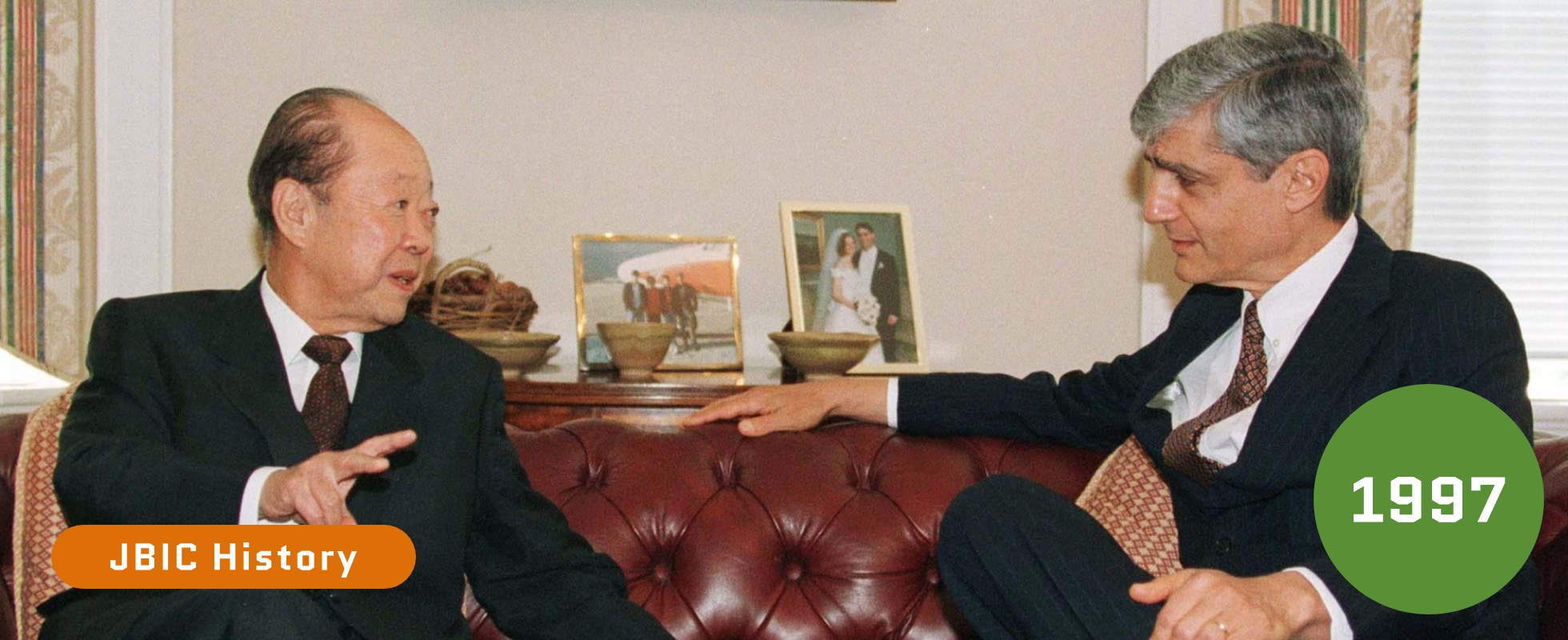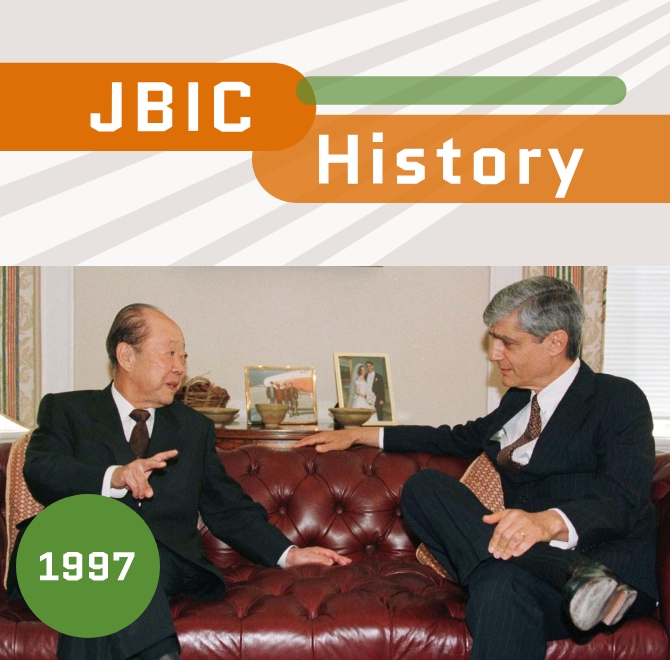JBIC History Vol.5
A financial crisis that started in Thailand in 1997 spread to other emerging markets.
At that time, JBIC’s predecessor, the Export-Import Bank of Japan (JEXIM), played a central role in Japan’s support for Asia.


Meeting between Finance Minister MIYAZAWA Kiichi and U.S. Treasury Secretary Robert Rubin at the October 1998 IMF-World Bank Annual Meetings. The New Miyazawa Initiative was announced at the meeting of Asian finance ministers and central bank governors held that same month. Photo: Reuters/AFLO
Accelerating trade and investment liberalization, and the East Asian economic miracle
Following the appreciation of the yen that was triggered by the 1985 Plaza Accord, Japan rapidly expanded its foreign direct investment and became a major overseas investor. A core element of Japan’s outward investment strategy was the establishment of production networks and export bases in Southeast Asian countries.
Trade and investment liberalization further accelerated in the 1990s, with the World Trade Organization (WTO) established in 1995. Financial markets became more globalized, and private capital investment in developing countries surged. Asian countries posted remarkable economic growth, and large amounts of highly liquid, short-term capital investment flowed into the region.
However, the Asian financial crisis struck in 1997. The “miracle” economic growth of Asian countries suffered a rude awakening.
The background to this was the fragility of the international financial system, which had itself been weakened by economic and financial globalization. Most emerging market economies had by then liberalized domestic and foreign capital transactions, and the fragility of their balance-of-payments structure was exposed.
On July 2, 1997, the Thai government shifted the baht from a dollar-peg to a managed floating exchange rate system, and the currency plunged in value. Speculative selling immediately spread to neighboring ASEAN countries and South Korea. A serious economic crisis then swept over the countries of Asia, even causing political and social unrest.
This crisis then spilled over to Russia and Brazil in 1998, intensifying global financial concerns. The contagion even reached Wall Street, leading to the collapse of major U.S. hedge fund LTCM.
As the financial crisis continued to spread, the New Miyazawa Initiative helped revive the regional economy
Japan’s government responded swiftly to help Asian countries overcome their economic difficulties and stabilize international financial and capital markets through an international framework including the IMF and the World Bank, as well as with its own assistance.
Meanwhile, JEXIM put its resources to work as part of the “New Miyazawa Initiative,” a USD30 billion bilateral support program, the largest of its kind during the crisis. JEXIM played a central role in Japan's support for Asia, providing financial sector adjustment lending in cooperation with the World Bank and other institutions; loans to government financial institutions to support local manufacturing industries (two-step loans); and capital assistance for infrastructure projects.
Through provision of ongoing support totaling JPY3.5 trillion up to March 2000, JEXIM contributed to the subsequent revitalization of East Asia’s economy.
On October 1, 1999, JEXIM was restructured with the birth of the Japan Bank for International Cooperation (the former JBIC) through the merger of JEXIM and the Overseas Economic Cooperation Fund (OECF). Until its final day, JEXIM provided support for Japan’s policy challenge of navigating the turbulent waters of financial globalization.
■Expansion of the Asian financial crisis and Japan’s support
| 1997 | July | Currency crisis in Thailand, the start of the Asian financial crisis |
|---|---|---|
| October | Currency crisis in Indonesia | |
| November | Currency crisis in South Korea | |
| 1998 | August | Financial crisis in Russia leads to global financial concerns |
| September | Collapse of U.S. hedge fund LTCM | |
| October | Announcement of the New Miyazawa Initiative | |
| 1999 | October | Export-Import Bank and Overseas Economic Cooperation Fund (OECF) merge to create the Japan Bank for International Cooperation (former JBIC) |






